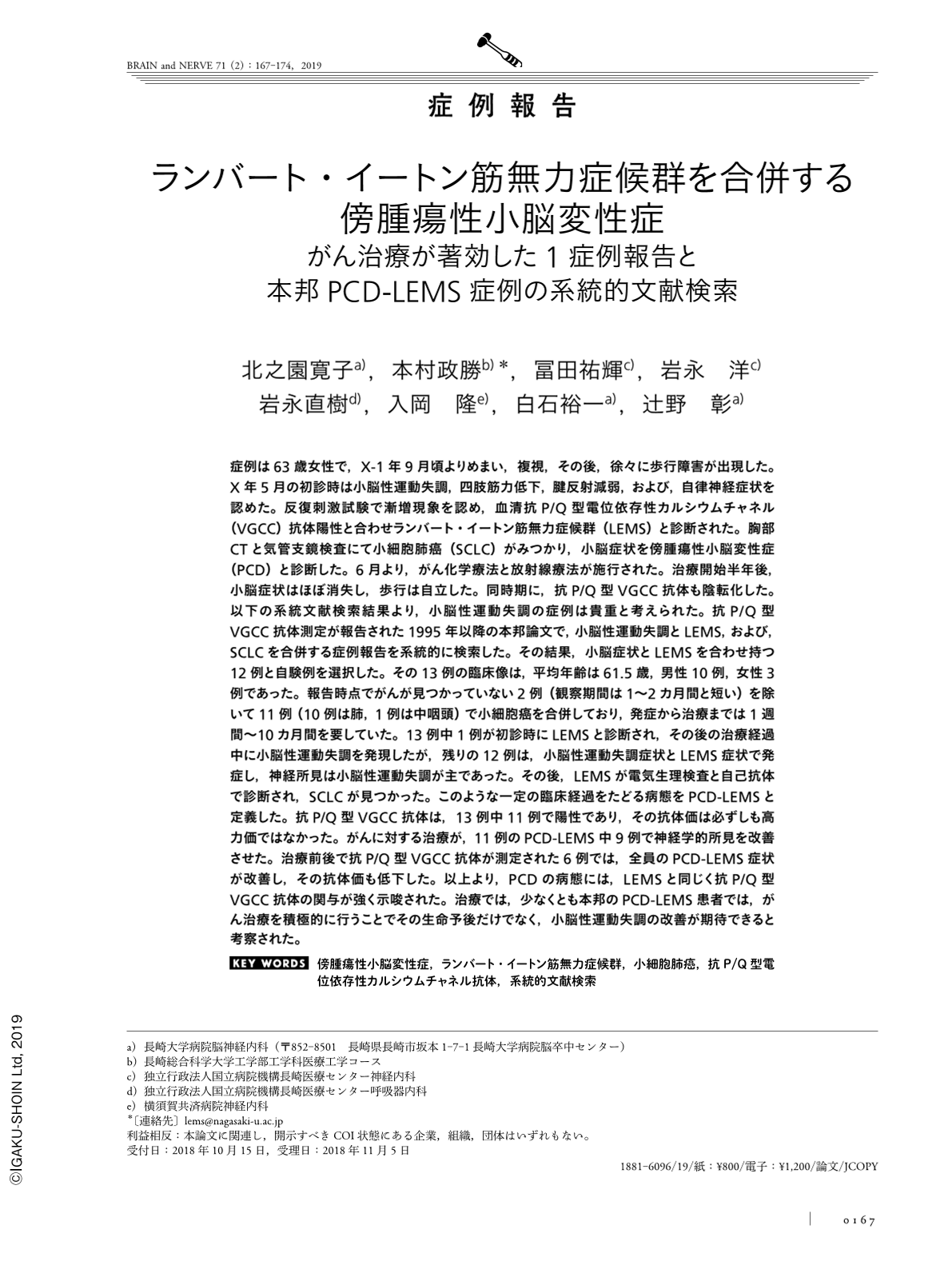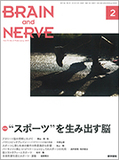Japanese
English
- 有料閲覧
- Abstract 文献概要
- 1ページ目 Look Inside
- 参考文献 Reference
症例は63歳女性で,X-1年9月頃よりめまい,複視,その後,徐々に歩行障害が出現した。X年5月の初診時は小脳性運動失調,四肢筋力低下,腱反射減弱,および,自律神経症状を認めた。反復刺激試験で漸増現象を認め,血清抗P/Q型電位依存性カルシウムチャネル(VGCC)抗体陽性と合わせランバート・イートン筋無力症候群(LEMS)と診断された。胸部CTと気管支鏡検査にて小細胞肺癌(SCLC)がみつかり,小脳症状を傍腫瘍性小脳変性症(PCD)と診断した。6月より,がん化学療法と放射線療法が施行された。治療開始半年後,小脳症状はほぼ消失し,歩行は自立した。同時期に,抗P/Q型VGCC抗体も陰転化した。以下の系統文献検索結果より,小脳性運動失調の症例は貴重と考えられた。抗P/Q型VGCC抗体測定が報告された1995年以降の本邦論文で,小脳性運動失調とLEMS,および,SCLCを合併する症例報告を系統的に検索した。その結果,小脳症状とLEMSを合わせ持つ12例と自験例を選択した。その13例の臨床像は,平均年齢は61.5歳,男性10例,女性3例であった。報告時点でがんが見つかっていない2例(観察期間は1〜2カ月間と短い)を除いて11例(10例は肺,1例は中咽頭)で小細胞癌を合併しており,発症から治療までは1週間〜10カ月間を要していた。13例中1例が初診時にLEMSと診断され,その後の治療経過中に小脳性運動失調を発現したが,残りの12例は,小脳性運動失調症状とLEMS症状で発症し,神経所見は小脳性運動失調が主であった。その後,LEMSが電気生理検査と自己抗体で診断され,SCLCが見つかった。このような一定の臨床経過をたどる病態をPCD-LEMSと定義した。抗P/Q型VGCC抗体は,13例中11例で陽性であり,その抗体価は必ずしも高力価ではなかった。がんに対する治療が,11例のPCD-LEMS中9例で神経学的所見を改善させた。治療前後で抗P/Q型VGCC抗体が測定された6例では,全員のPCD-LEMS症状が改善し,その抗体価も低下した。以上より,PCDの病態には,LEMSと同じく抗P/Q型VGCC抗体の関与が強く示唆された。治療では,少なくとも本邦のPCD-LEMS患者では,がん治療を積極的に行うことでその生命予後だけでなく,小脳性運動失調の改善が期待できると考察された。
Abstract
A 63-year-old female who developed dizziness, diplopia and subsequent gait disturbance from September X-1 year was analyzed. The first neurological findings in May X year revealed cerebellar ataxia, weakness in the proximal limbs, decreased tendon reflexes, and autonomic symptoms (ADL:mRS 3). Furthermore, an incremental phenomenon was observed in the repetitive nerve stimulation test, and she was diagnosed with Lambert-Eaton myasthenic syndrome (LEMS) based on the serum P/Q-type calcium channel (VGCC) antibody positivity. In addition, small cell lung cancer was detected by chest CT and bronchoscopy, and her cerebellar ataxia was diagnosed as paraneoplastic cerebellar degeneration (PCD). Therefore, the patient underwent chemotherapy and radiotherapy from June in X year. Six months after initiation of treatment, her cerebellar ataxia had almost disappeared and she could walk without assistance (ADL:mRS 1). The P/Q-type VGCC antibodies were also negative at that time. Cases wherein cerebellar ataxia resolved almost completely in parallel with disappearance of the serum P/Q-type VGCC antibodies are of great interest. We conducted a systematic literature review of PCD-LEMS cases in Japan reported since P/Q-type calcium channel antibody measurement was reported in 1995. As a result, 13 cases (including our study) that concurrently displayed cerebellar ataxia and LEMS were selected. The average age of the 13 patients (10 males and 3 females) was 61.5 years. Small cell carcinoma was complicated in 11 patients (10 in the lung and 1 in the oropharynx); in the other 2 patients, cancer was not found at the time of reporting (the observation period was as short as 1-2 months). The time from onset to treatment ranged between 1 week and 10 months. While 1 of the 13 patients developed cerebellar ataxia during the subsequent course of the treatment, the remaining 12 had already developed cerebellar ataxia and LEMS symptoms, although their main neurologic finding was cerebellar ataxia and they were subsequently diagnosed with LEMS after electrophysiological testing and autoantibody detection. Small cell carcinoma was found in 11 patients. We define the pathology following such a certain clinical course as PCD-LEMS. The P/Q-type VGCC antibodies were positive in 11 of the 13 cases, although their antibody titers were not necessarily very high. Treatment for the associated small cell carcinoma might have improved the neurological findings in 9 of the 11 PCD-LEMS patients. The P/Q-type VGCC antibodies were measured before and after the treatment. The PCD-LEMS symptoms improved in all patients and their antibody titers decreased. These findings indicate that P/Q-type VGCC antibodies are involved in the pathology of PCD-LEMS. Appropriate and timely treatment, at least in PCD-LEMS patients in Japan, that actively treats any associated cancer can be expected to improve not only life prognosis but also cerebellar ataxia.
(Received October 15, 2018; Accepted November 5, 2018; Published January 1, 2019)

Copyright © 2019, Igaku-Shoin Ltd. All rights reserved.


